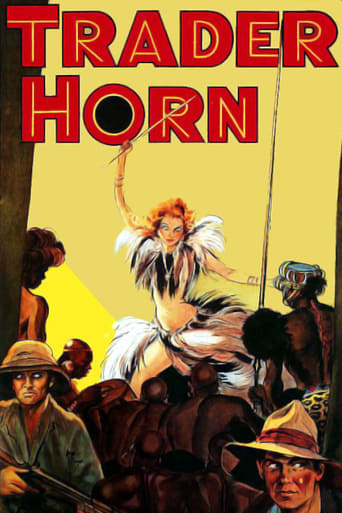Bill Rindone
With a background spanning over twenty years in the African bush during the 60's, 70's and 80's I am amazed at the locations used for filming. In 1930 (film released in '31) the areas used were very remote and still are over eighty years later. Part of the film was shot on the eastern shore of Lake Tanganyika along with another in the interior of Uganda. The Pygmy (Efe) segment is from the Ituri Forest in what is now the Democratic Republic of Congo and besides being very remote and hazardous was, and still is, an unhealthy area. As recent as 2003, marauding rebels were seizing Pygmy hunters and eating them according to the U.N. Uganda, Tanganyika (Tanzania) and the southern Sudan were rampant with Malaria and a number of production crew fell ill with it. The Tse Fly was the bearer of Sleeping Sickness and prevalent in these areas as well as the Kenya Colony where some filming took place.Although the plot is lacking by today's standards, the commitment to film in these areas was a major attempt to show the real Africa of its time along with footage of it's indigenous Flora and Fauna. Due to this diligence, today we have a timed photographic encapsulation of these areas available to the general public which is not readily accessible elsewhere.
Robert J. Maxwell
W. S. ("One-Take Woody") Van Dyke assembled one of those movies about two intrepid white men (Carey and Renaldo) trekking through the bush in search of a lost missionary's daughter. Whether or not they find her, and under what circumstances, I leave to the viewer's guess. Carey is the savvy white explorer and Renaldo is the handsome young novice, whom Carey calls "Laddie." It's not as racist as one might expect from a 1931 movie, and much of the spectacular footage was shot in Kenya and the Congo. The movie takes a reasonably sensible attitude towards "the beasts" they encounter too, though they chuckled as they shoot and kill crocodiles on the banks of the river. "You just wounded him," chides Carey, good-naturedly. As far as I could tell, they got the names of the beasts right -- gnus vs wildebeests; the black panther being a melanistic leopard -- and the tribal names too -- Masai and Kikuyu. (Remember the Mau Mau? They were mostly Kikuyu.) It had been nine years since "Nanook of the North" made a splash, and this splash is bigger and has stars with names, and they don't look like Nanook and his pals. But it's all old hat by now.The film must have gone over big with audiences in 1931. They got not only rhinoceroses but Duncan Renaldo is a pith helmet the size of a rain barrel and the configuration of a flying saucer.
lamorak13
I took a chance on this with a purchase from one of the internet companies manufacturing DVDs from long out of print movie sources. This is a leisurely black and white film of two hours that peaked my interest on several occasions and kept me watching, avidly, for the entire course. The cast is great, with Carey playing a tough hunter-trader who nevertheless displays his tender moments as well. Renaldo, apparently a Romanian at birth, later became the Cisco Kid star of the television serial, plays a likable young man. The lovely Booth, who first appears as little more than a blonde animal, slowly begins to get in touch with her feminine side as the movie progresses. I liked these people along with the stoic and dependable gun-bearer. Filmed over seven months in just the right locations in Africa, the crew was plagued by the hostile elements: Booth became extremely ill as a consequence, and two extras actually died, one to a crocodile and the other to a charging rhinoceros. The movie therefore touched me personally and brought back old memories. In 1978 at the age of 23, the same age that Renaldo plays in the movie, I spent six months in Africa, first crossing the Sahara north to south, then from north Nigeria into Chad and into the Cameroon, Central African Empire, Zaire, and out through Uganda into Kenya. Judging from my experience, I believe that much of the film took place in the Cameroon, Central African Empire and northeastern Zaire (Congo). My troubles were not with marauding tribesmen, but with killer bees, various revolutions, sundry criminals, millions of army ants, bad water, and scorpions, etc. I personally attest that these are real Africans, real African villages, real animals, and this authenticity, including the native drums, brought me back to my youth and life living on the ground in a small tent through similar villages and terrain. Three exciting phases in the film hit me hard: all while in the native villages. When you are vastly outnumbered on somebody else's terrain and they are armed with spears and growing excited from the relentless throb of the drums, you might count your life in seconds. Ah, but it beats dying slowly behind a desk! You will flinch at several of the racist words in this film, but will also recognize the love and respect between Carey and his gun-bearer. Such emotions come easy between men who have each other's backs. Grab this film and sit back and enjoy without distraction!
dukeb0y
TRADER HORN, 1931 is quite an adventure story. I just watched it on TMC, and it sure deserves a digital clean up. The quality of the print had faded over the years, but the excitement has not.Being a 'pre-code' movie, we have some strong scenes. For example, the two whites and one native are about to be crucified, upside down, till the White Goddess steps in to save them. That would get an 'R' rating today! Vintage footage of Natives and wildlife in Africa, is very real, because it was filmed there. And the 'National Geographic' style topless natives are there too.Toward the end, the white adventurer, saves his wounded native helper, and carries him away from danger. I mention this because I don't think we would see this in an American film in the 1930s. Also we see the native looking back, like a spirit, up in the clouds, near the end. Interesting movie.I would like to see this film restored.




